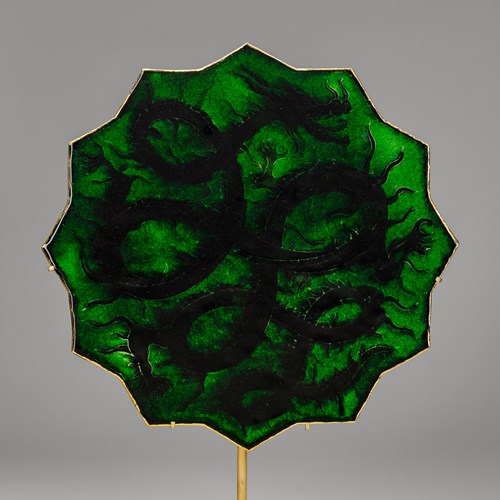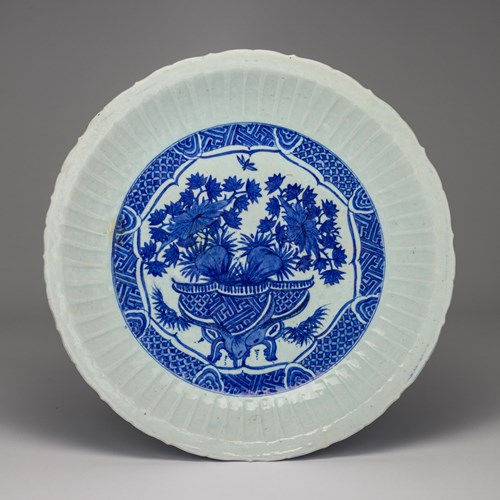Marketplace
Chinese Painting made for the Indian Market
Chinese Painting made for the Indian Market
Period 19th century
Medium Gesso, Gouache, Gold leaf
Dimension 58.5 x 45 cm (23 x 17³/₄ inches)
The Hindu god Shiva, identified by his third eye and trishul or trident, which are his key markers, is depicted in this painting seated on the back of the bull Nandi or Vrishabha (his divine vehicle or vahana), who gazes lovingly upon them, in this painting. With a base of canvas placed over wood , it is covered in gesso, and painted with gouache and gold leaf. Shiva sits in lalitasana with a young boy on his left thigh. They are bare chested but covered in jewels, shoulder plates and heavily ornamented helmets. In his three arms he carries what could be a damaru (a handheld drum), a trishul connected to wavering garland ending in what would typically be a mriga (deer) but here appears as a mouse-like animal. All ornamentation across the people and the bull, and weapons are done in gold paint.
This is a very interesting painting, highlighting cross-cultural interpretations of art and mythological representations. It is likely a Chinese recreation of a very commonly found theme in South Indian paintings, particularly Tanjore religious paintings. A number of factors point towards the painter not being Indian and having a limited knowledge of the subject matter. Apart from the faces of the people and the bull being not in the Indian style, a major distinction from paintings of this theme is that the person sitting on Shiva’s left leg is not a boy, but in fact, typically his wife Parvati, draped in a sari. This theme does not usually include either of Shiva’s sons and is thus more likely to be a misunderstanding by the painter, based on his or her unfamiliarity with the mythology. Similarly, while in this painting, Shiva only has three arms, when he is usually depicted with four. Two of these four are, generally, then shown holding objects while the other two are shown in different mudras or hand gestures, or one arm is around his wife. In this, one arm is around the boy, while the other two are holding a trident and a drum. The small mouse-like animal shown rather than a small deer is also another instance of misunderstanding the standard subject matter that was being copied. One last but glaring difference between paintings made by Indians and a Chinese painting is the depiction of the gods wearing shoes.
Traditionally, Tanjore or Thanjavur paintings were made on canvas pasted over a plank of wood. The fabric was covered with a fine clay ground layer or chalk or powdered limestone to create a smooth surface for the painting. The artist would then sketch the outlines of the painting in ink. Gold leaves and gems of varied colours were inlaid in selected areas like pillars, arches, thrones, dresses, etc. Finally, colours were applied on the sketch. This painting lacks the addition of gems that would be inlaid in a traditional Tanjore painting.
Similar imagery is found in Tanjore paintings, Company paintings, and Trichinopoly Style paintings and sculpture:
https://www.britishmuseum.org/collection/object/A_1962-1231-0-13-91
https://www.britishmuseum.org/collection/object/A_2007-3005-21
https://www.britishmuseum.org/collection/object/A_1993-0806-0-48
https://collections.vam.ac.uk/item/O83005/shiva-on-nandi-figure-unknown/
https://collections.vam.ac.uk/item/O404880/shiva-and-parvati-riding-on-drawing-unknown/
https://collections.asianart.org/conservation-of-a-south-asian-painting/
This is a very interesting painting, highlighting cross-cultural interpretations of art and mythological representations. It is likely a Chinese recreation of a very commonly found theme in South Indian paintings, particularly Tanjore religious paintings. A number of factors point towards the painter not being Indian and having a limited knowledge of the subject matter. Apart from the faces of the people and the bull being not in the Indian style, a major distinction from paintings of this theme is that the person sitting on Shiva’s left leg is not a boy, but in fact, typically his wife Parvati, draped in a sari. This theme does not usually include either of Shiva’s sons and is thus more likely to be a misunderstanding by the painter, based on his or her unfamiliarity with the mythology. Similarly, while in this painting, Shiva only has three arms, when he is usually depicted with four. Two of these four are, generally, then shown holding objects while the other two are shown in different mudras or hand gestures, or one arm is around his wife. In this, one arm is around the boy, while the other two are holding a trident and a drum. The small mouse-like animal shown rather than a small deer is also another instance of misunderstanding the standard subject matter that was being copied. One last but glaring difference between paintings made by Indians and a Chinese painting is the depiction of the gods wearing shoes.
Traditionally, Tanjore or Thanjavur paintings were made on canvas pasted over a plank of wood. The fabric was covered with a fine clay ground layer or chalk or powdered limestone to create a smooth surface for the painting. The artist would then sketch the outlines of the painting in ink. Gold leaves and gems of varied colours were inlaid in selected areas like pillars, arches, thrones, dresses, etc. Finally, colours were applied on the sketch. This painting lacks the addition of gems that would be inlaid in a traditional Tanjore painting.
Similar imagery is found in Tanjore paintings, Company paintings, and Trichinopoly Style paintings and sculpture:
https://www.britishmuseum.org/collection/object/A_1962-1231-0-13-91
https://www.britishmuseum.org/collection/object/A_2007-3005-21
https://www.britishmuseum.org/collection/object/A_1993-0806-0-48
https://collections.vam.ac.uk/item/O83005/shiva-on-nandi-figure-unknown/
https://collections.vam.ac.uk/item/O404880/shiva-and-parvati-riding-on-drawing-unknown/
https://collections.asianart.org/conservation-of-a-south-asian-painting/
Period: 19th century
Medium: Gesso, Gouache, Gold leaf
Signature: Stock no.: A4698
Dimension: 58.5 x 45 cm (23 x 17³/₄ inches)
More artworks from the Gallery





_T638839371761583625.jpg?width=500&height=500&mode=pad&scale=both&qlt=90&format=jpg)



